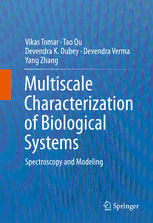
Multiscale Characterization of Biological Systems: Spectroscopy and Modeling PDF
Preview Multiscale Characterization of Biological Systems: Spectroscopy and Modeling
Vikas Tomar · Tao Qu Devendra K. Dubey · Devendra Verma Yang Zhang Multiscale Characterization of Biological Systems Spectroscopy and Modeling Multiscale Characterization of Biological Systems Vikas Tomar (cid:129) Tao Qu (cid:129) Devendra K. Dubey Devendra Verma (cid:129) Yang Zhang Multiscale Characterization of Biological Systems Spectroscopy and Modeling Vikas Tomar Tao Qu Purdue University Purdue University West Lafayette , IN , USA West Lafayette , IN , USA Devendra K. Dubey Devendra Verma Indian Institute of Technology Delhi Purdue University New Delhi , Delhi , India West Lafayette , IN , USA Yang Zhang Purdue University West Lafayette , IN , USA ISBN 978-1-4939-3451-5 ISBN 978-1-4939-3453-9 (eBook) DOI 10.1007/978-1-4939-3453-9 Library of Congress Control Number: 2015953098 Springer New York Heidelberg Dordrecht London © Springer Science+Business Media New York 2015 T his work is subject to copyright. All rights are reserved by the Publisher, whether the whole or part of the material is concerned, specifi cally the rights of translation, reprinting, reuse of illustrations, recitation, broadcasting, reproduction on microfi lms or in any other physical way, and transmission or information storage and retrieval, electronic adaptation, computer software, or by similar or dissimilar methodology now known or hereafter developed. The use of general descriptive names, registered names, trademarks, service marks, etc. in this publication does not imply, even in the absence of a specifi c statement, that such names are exempt from the relevant protective laws and regulations and therefore free for general use. T he publisher, the authors and the editors are safe to assume that the advice and information in this book are believed to be true and accurate at the date of publication. Neither the publisher nor the authors or the editors give a warranty, express or implied, with respect to the material contained herein or for any errors or omissions that may have been made. Printed on acid-free paper Springer Science+Business Media LLC New York is part of Springer Science+Business Media (www.springer.com) To Samarth, Yash, and Swati Pref ace I nspired by a remarkable combination of physical and mechanical properties in biological materials, a new research fi eld has evolved that focuses on studying these materials for the underlying principles and mechanisms of operation in order to incorporate such into the engineered materials. This fi eld or stream of materials science referred to as “Bioenabled and Biomimetic Materials” has attracted imagination of a range of scientifi c disciplines. The key of natural- or nature-inspired design of materials is different, organized scale levels (nano- to macroscale) of structural arrangement with the presence of the interface between the organic and inorganic phases at each level. The accurate knowledge of such design principle is needed to optimize performance of biomimetic materials for required loading condition and operation. Two aspects of this knowledge are the accurate characterization of the organic–inorganic interfaces and the quantitative study of the contributor of different interfaces and structural arrangements to the consequent improvements in mechanical properties (e.g., stiffness, strength, toughness, etc.). Another important aspect of this design is the development of an ability to better manufacture traditionally developed composites. This collection focuses on the work done by Interfacial Multiphysics Lab and collaborators on the fi rst aspect. The fi eld of biomimetic materials is still in its beginning and growing. This work’s primary contribution is in its focus on interfaces from the point of views of experiments and multiscale models. A uthors are immensely grateful to collaborators such as Prof. Christian Hellmich at TU Vienna, Prof. Kalpana Katti at North Dakota State University, Prof. Huajian Gao at Brown University, Prof. Markus Buehler at MIT, and Prof. Glen Niebur at University of Notre Dame in indirectly or directly providing great motivation and discussions. The book contains a discussion of work by a range of researchers in vii viii Preface this area. Permission was obtained for fi gures borrowed to appear in review papers and book chapters on which the book is based. We remain indebted for the related colleagues for providing required permissions. West Lafayette, IN, USA Vikas Tomar West Lafayette, IN, USA Tao Qu New Delhi, Delhi, India Devendra K. Dubey West Lafayette, IN, USA Devendra Verma West Lafayette, IN, USA Yang Zhang Contents 1 Introduction ................................................................................................. 1 References ..................................................................................................... 3 2 Spectroscopic Experiments: A Review of Raman Spectroscopy of Biological Systems ................................................................................... 5 2.1 Introduction .......................................................................................... 5 2.2 Instrumentation .................................................................................... 8 2.3 Identifi cation of Algae Species Using Raman Spectroscopy ............... 10 2.4 Study of Component Biomolecules ..................................................... 11 2.5 Conclusions .......................................................................................... 16 References ..................................................................................................... 17 3 Nanomechanics Experiments: A Microscopic Study of Mechanical Property Scale Dependence and Microstructure of Crustacean Thin Films as Biomimetic Materials ................................ 21 3.1 Methods ................................................................................................ 23 3.1.1 Nanoindentation ....................................................................... 23 3.1.2 Experimental Setup .................................................................. 24 3.1.3 Scanning Electron Microscopy (SEM) and Energy- Dispersive X-Ray (EDX) ..................................... 26 3.1.4 Sample Preparation .................................................................. 26 3.1.5 Substrate Effect ........................................................................ 26 3.2 Results .................................................................................................. 27 3.3 Conclusion ........................................................................................... 33 References ..................................................................................................... 33 4 Molecular Modeling: A Review of Nanomechanics Based on Molecular Modeling ............................................................................... 37 4.1 Introduction .......................................................................................... 37 4.2 Bioengineering and Biomimetics ......................................................... 38 4.2.1 Bone ......................................................................................... 39 4.2.2 Nacre ........................................................................................ 50 ix
